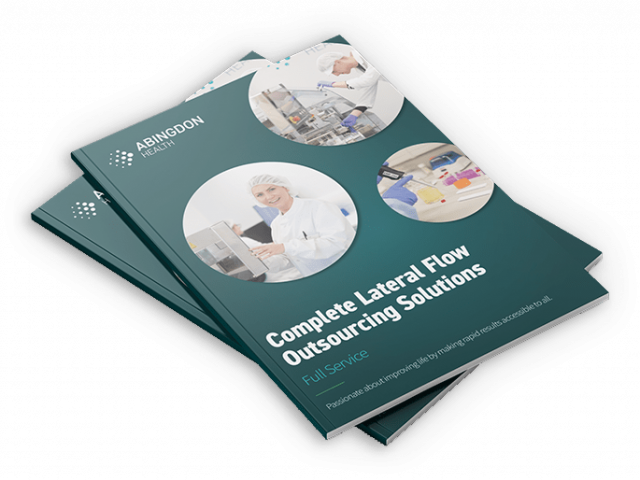Ensuring your critical components are protected – the importance of supply agreements

What Are Lateral Flow Assays?
Understanding the Vulnerability of Component Supply
Building Resilience with Supply Agreements
Key Takeaways
In this blog Abingdon’s Chief Operating Officer, Mark Jones, considers the importance of putting in place supply agreements to ensure supply and quality of critical components used within lateral flow test production is assured.
What are Lateral Flow Assays?
Lateral Flow Assays (LFAs) have risen to prominence in recent years and in-particular with the advent of Covid-19. LFAs offer rapid, point-of-care diagnostics for diverse applications including viral detection, pregnancy and fertility testing, environmental, food safety and agriculture. Like any test, they rely on a precise interplay of components, with Antigens, Antibodies, Nanoparticles, Membranes and Housings playing a pivotal role in accuracy and reliability. Disruptions in the supply of these components can have major consequences, impacting research, clinical testing, public health interventions and treatment management decisions. This is where well-crafted supply agreements come into play, serving as a vital line of defence for ensuring development and final assay continuity and protecting against unforeseen bottlenecks.
There is a very informative video on our website explaining in more detail how lateral flow technology works, if you’d like to know more.
Understanding the Vulnerability of Component Supply
Several factors contribute to the vulnerability. Key factors include:
-
-
-
-
-
- Specificity and sensitivity: LFA reagents, often involving antibodies and antigens, are highly specific, and their effectiveness hinges on precise molecular recognition. This specificity limits the number of potential suppliers, leaving developers highly reliant on a relatively small pool of providers.
- Manufacturing complexities: Production of LFA reagents often involves intricate bioconjugation processes and quality control measures. This complexity can lengthen lead times and limit readily available alternatives in case of disruptions. If you have designed bespoke components like housings or sample collection items, these are likely not held on stock and subject to dedicated manufacturing runs which can have lengthy lead times.
- Global market dynamics: Demand for LFA components can fluctuate dramatically depending on outbreaks, public health initiatives, and research trends. This volatility can create supply shortages and price fluctuations, impacting developers and users alike.
-
-
-
-
Building Resilience with Supply Agreements
To mitigate these risks and ensure a stable supply of critical components, robust supply agreements with manufacturers should be considered at the earliest opportunity. Abingdon Health places significant emphasis of getting these agreements in place at the earliest opportunity and we have a dedicated supply chain team with vast experience of working across the industry who are involved in our development and transfer projects from day one.
Some important considerations in building these supply agreements are set out below:
Minimum order quantities and delivery schedules: Establishing guaranteed minimum orders and defined delivery schedules with reliable suppliers provides some level of predictability and mitigates the risk of sudden shortages.
Quality control and specifications: Stringent quality control measures and clearly defined specifications for reagents and components are crucial to maintain assay accuracy and reliability. The agreement should define testing protocols and acceptance criteria for all batches of reagents.
Contingency plans and force majeure clauses: Unexpected events like production delays, raw material shortages, or natural disasters can disrupt supply chains. Having contingency plans and clear force majeure clauses outlined in the agreement ensures transparency and minimises disruption in such scenarios.
Intellectual property protection: LFAs often involve proprietary designs and reagents. The agreement should safeguard intellectual property rights and prevent unauthorized production or distribution.
Building Strong Partnerships: A successful supply chain for LFA components goes beyond a well-written agreement. It is important to build and nurture strong relationships with suppliers. Regular communication keeps you informed of potential challenges and allows for proactive planning. Additionally, collaborating on process optimization and innovation can benefit both parties in the long run.
Proactively manage your supply agreements: Establishing supply agreements is just the start of your partnership with key component suppliers. As set out above building strong partnerships is important. It is also key to manage these supply agreements to ensure adherence to the key contractual terms. Also, supply agreements tend to be time limited so it is important to ensure these agreements are rolled forward at the end of the contract period or alternative suppliers are established and contracted with, well in advance of contract expiry. Proactive contract management is key.
Key Takeaways
It is important to understand the vulnerabilities of LFA component supply, and effectively manage the risks associated by executing and managing a well-written supply agreement.
Taking proactive steps through well-crafted agreements will help secure the uninterrupted flow of these critical components. Building strong relationships with manufacturers further strengthens the supply chain and fosters a collaborative environment for continuous improvement.
In a world where rapid and reliable diagnostics are becoming increasingly critical to tackling diverse and ever-growing challenges, ensuring component supply is a must for uninterrupted supply of your product to improve the wellbeing of your chosen targets.
Abingdon Health’s team has over 20 years’ experience in the lateral flow market and is a knowledge leader in the scale-up, transfer, manufacturing and regulatory approval of lateral flow products across a range of sectors. Our supply chain team is involved in your project from day one to ensure surety of supply of all components both in development and manufacturing.
If you would like to understand more about the development, technical transfer, manufacturing and regulatory process and discuss any specific requirements please contact us using the form below.

